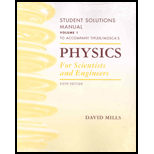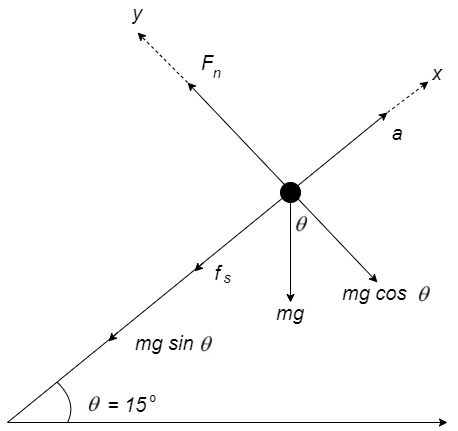
Concept explainers
(a)
To Calculate: The minimum distance to make the car stop.
(a)
Answer to Problem 48P
The minimum distance it takes to stop the car is
Explanation of Solution
Given Information:
An automobile is going up a
The coefficient of static friction between the tires and the road is
Formula Used:
Third equation of motion:
Where symbols have their usual meanings.
Calculation:
Initial velocity of the automobile
Final velocity of the automobile
Let the minimum displacement be
Let the acceleration of the car be
Free body diagram for automobile going up the inclined plane is shown below

Use the third kinematics relation
From the free body diagram, along the x-axis
Along the y-axis:
Substitute
Substitute the value of acceleration in
Conclusion:
Thus, the minimum stopping distance is
(b)
To Calculate: The minimum distance it would take to stop if the car were going down the grade.
(b)
Answer to Problem 48P
Explanation of Solution
Given Information:
An automobile is going up a
The coefficient of static friction between the tires and the road is
FormulaUsed:
Third equation of motion:
Where, symbols have their usual meanings
Calculation:
Initial velocity of the car
Final velocity of the car
Let the minimum displacement be
And let the acceleration of the car be
Use the third kinematic equation
Along the x-axis
And along the y-axis we conclude that,
Substitute
Substitute the value of acceleration in
Here, the negative sign indicates that the displacement of the car is in the opposite direction as in part
Conclusion:
Therefore, the magnitude of displacement is
Want to see more full solutions like this?
Chapter 5 Solutions
Physics For Scientists And Engineers Student Solutions Manual, Vol. 1
- A child wants to pull a wagon with a mass of 5.0 kg up a hill, the slope of which forms an angle of 8° with respect to the horizontal. If the child is on the slope, with the trolley stationary, what is the coefficient of static friction?arrow_forwardA 250 N block is initially at rest on a flat surface that is inclined at 30°. if the coefficient of the static friction is 0.30, find the force required to start the block moving up the plane.arrow_forwardA 6.7 kg mass is released from rets while on an incline of 53.96 degrees. If the coefficient of kinetic friction is 0.478 what is the magnitude of the acceleration of the mass?arrow_forward
- If the coefficient of kinetic friction, , between the block and the surface is 0.30 and the magnitude of the frictional force is 80.0 N, what is the weight of the block? ( Assume the block is on a horizontal surface)arrow_forwardA 250lb block is initially at rest on the flat surface that is inclined at 30 degree. If the coefficient of kinetic friction is 0.30 and the coefficient of static friction is 0.40, find the force required to start the block moving up the planearrow_forwardA box with a mass of 0.5 slugs lies on an inclined plane making an angle of 30o with the horizontal. If the coefficient of kinetic friction between the box and the plane is 0.4, what is the magnitude of the force that must be applied parallel to the incline to keep the box moving down the incline at a constant speed?arrow_forward
- What force must be applied to push a carton weighing 260 N up a 18 degree incline, if the coefficient of kinetic friction is 0.41? Assume the force is applied parallel to the incline and the velocity is constant. (Enter the magnitude of the force.)arrow_forwardA 4.45 x 104N truck is travelling at 100 km/h. If the coefficient of friction between the tires and the roadway is 0.50, whatis the minimum distance the truck will go before stopping?arrow_forwardA 4.00 kg block rests on a 30 degree incline. If the coefficient of the static friction between the block and the incline is 0.700, what magnitude of horizontal force F must act on the block to start it moving up the incline?arrow_forward
- In a pickup game of dorm shuffleboard, students crazed by final exams use a broom to propel a calculus book along the dorm hallway. If the 3.5 kg book is pushed from rest through a distance of 0.90 m by the horizontal 25 N force from the broom and then has a speed of 1.60 m/s, what is the coefficient of kinetic friction between the book and floor?arrow_forwardFind the force (F) to move the box given that the coefficient of static friction is 0.2arrow_forwardA 160 kg golf cart is traveling at 25 m/sec on a level surface with a coefficient of kinetic friction equal to 0.5. What is the kinetic friction force, if the brakes are locked?arrow_forward
 College PhysicsPhysicsISBN:9781305952300Author:Raymond A. Serway, Chris VuillePublisher:Cengage Learning
College PhysicsPhysicsISBN:9781305952300Author:Raymond A. Serway, Chris VuillePublisher:Cengage Learning University Physics (14th Edition)PhysicsISBN:9780133969290Author:Hugh D. Young, Roger A. FreedmanPublisher:PEARSON
University Physics (14th Edition)PhysicsISBN:9780133969290Author:Hugh D. Young, Roger A. FreedmanPublisher:PEARSON Introduction To Quantum MechanicsPhysicsISBN:9781107189638Author:Griffiths, David J., Schroeter, Darrell F.Publisher:Cambridge University Press
Introduction To Quantum MechanicsPhysicsISBN:9781107189638Author:Griffiths, David J., Schroeter, Darrell F.Publisher:Cambridge University Press Physics for Scientists and EngineersPhysicsISBN:9781337553278Author:Raymond A. Serway, John W. JewettPublisher:Cengage Learning
Physics for Scientists and EngineersPhysicsISBN:9781337553278Author:Raymond A. Serway, John W. JewettPublisher:Cengage Learning Lecture- Tutorials for Introductory AstronomyPhysicsISBN:9780321820464Author:Edward E. Prather, Tim P. Slater, Jeff P. Adams, Gina BrissendenPublisher:Addison-Wesley
Lecture- Tutorials for Introductory AstronomyPhysicsISBN:9780321820464Author:Edward E. Prather, Tim P. Slater, Jeff P. Adams, Gina BrissendenPublisher:Addison-Wesley College Physics: A Strategic Approach (4th Editio...PhysicsISBN:9780134609034Author:Randall D. Knight (Professor Emeritus), Brian Jones, Stuart FieldPublisher:PEARSON
College Physics: A Strategic Approach (4th Editio...PhysicsISBN:9780134609034Author:Randall D. Knight (Professor Emeritus), Brian Jones, Stuart FieldPublisher:PEARSON





